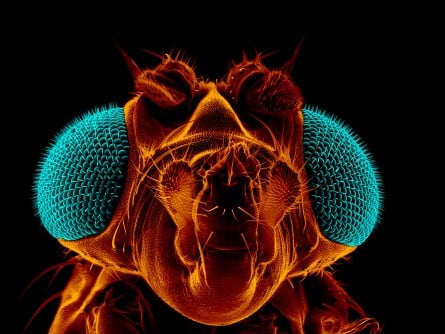URGENT UPDATE: Florida Atlantic University neuroscientists have made a groundbreaking discovery about the protein “Frazzled,” revealing its critical role in the nervous system of fruit flies. This urgent finding, published in the journal eNeuro, highlights how Frazzled aids in the swift connection and communication between neurons, a function vital for all nervous systems from insects to humans.
The researchers focused on the Giant Fiber (GF) System of Drosophila, a neural circuit responsible for the rapid escape reflex in fruit flies. Their study shows that without Frazzled, neurons fail to form effective electrical connections, significantly slowing down neural responses and weakening communication between GF neurons and the muscles they control. These defects are directly linked to a loss of gap junctions, essential channels that allow for rapid signal transmission.
Dr. Rodney Murphey, the senior author and professor of biological sciences at FAU, stated, “The combination of experimental and computational work allowed us to see not just that Frazzled matters, but exactly how it shapes the connections that let neurons talk to each other.” The team’s innovative approach combined genetics, imaging, physiology, and computational modeling, revealing that even minor alterations in gap junction density can drastically impact the speed and precision of neural signals.
In a significant finding, the researchers discovered that restoring just the intracellular portion of the Frazzled protein was sufficient to revive both the structure of synapses and enhance neuronal communication speed. However, disruptions to this portion, particularly the P3 domain, led to failures in restoring function, underscoring the importance of Frazzled’s role in gene activity regulation crucial for forming gap junctions.
Beyond laboratory experiments, the team developed a computational model of the GF System to simulate the impact of gap junctions on neuronal firing reliability. This model confirmed that small changes could lead to substantial variations in neural signaling, emphasizing the delicate balance required for effective communication within nervous systems.
Interestingly, while Frazzled has previously been recognized as a guidance molecule aiding neuron growth along correct pathways, this study unveils its dual role in regulating synapse formation directly. Flies lacking Frazzled exhibited erratic neuron growth, failing to reach their intended targets, but restoring the intracellular domain rectified many of these issues.
As the team looks ahead, they aim to investigate whether similar mechanisms exist in other species, including mammals, and how these may influence processes like learning, memory, and recovery from injuries.
Dr. Juan Lopez, the study’s first author and a postdoctoral researcher, emphasizes the broader implications of this research. “Understanding how neurons form reliable connections is a central question in neuroscience,” he asserted. The findings from this study not only shed light on fundamental neuroscience questions but also open new avenues for exploring neurodegenerative diseases and strategies for repairing damaged neural circuits.
The research underscores the importance of Frazzled and its relatives in shaping neural networks, suggesting a conserved role across various organisms. As such, this study marks a significant step forward in neuroscience, providing critical insights into the mechanisms that govern neural connectivity.
Stay tuned for further updates on this developing story as researchers continue to explore the implications of these findings for neuroscience and potential therapeutic approaches.







